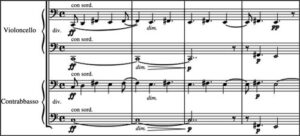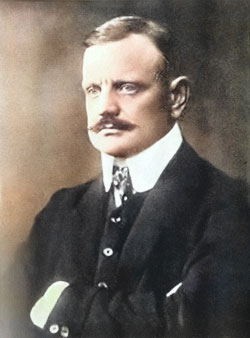Symphony No. 4 in A minor, Op. 63
Jean Sibelius Complete Works (JSW), Series I (Orchestral works) Vol. 5 – SON 635
edited by Tuija Wicklund

The opening bars of the symphony
‘It really is too subtle and tragic for our miserable world.’ – Sibelius about his Fourth Symphony, diary, 14 September 1912
With the Fourth Symphony, the JSW edition arrives at a crucial work in the composer’s output: the darkest and most unsmiling of his symphonies, and the one in which he comes closest to musical expressionism. Everything in the Fourth Symphony is pared back to the bare minimum. As Sibelius’s biographer Erik Tawaststjerna put it, it represents ‘the monumentalism of antimonumentalism’. It is also the ultimate illustration of the advice Sibelius gave to younger composers: ‘Never write a superfluous note’. The symphony was also close to its composer’s heart. In the 1940s he commented: ‘I am pleased that I did it, for even today I cannot find a single note in it that I could remove, nor can I find anything to add. This gives me strength and satisfaction. The Fourth Symphony represents a very important and great part of me. Yes, I’m glad to have written it.’ Its slow movement was one of the pieces played at his funeral.
Breitkopf & Härtel published the symphony in 1912 and now, more than a century later, comes this definitive critical edition of the score. The introduction to this new volume includes a detailed history of the genesis of the symphony with special reference to its overlap with the projected orchestral song Korpen (The Raven; Edgar Allan Poe) that Sibelius planned to write for Aino Ackté. Previous literature has assumed that some of the material for the song was reused in the finale of the symphony, but Tuija Wicklund reveals the situation to be more complex and less clear-cut, concluding: ‘in light of the few surviving sketches it is impossible to verify whether Sibelius originally incorporated the musical ideas [from various sketches] into Korpen or the symphony’.
Much attention is also paid to the symphony’s initial critical reception. It was performed only twice in April 1911 before the composer started to revise it for publication; the next performances took place almost a year later. This was more or less standard practice for Sibelius in his major works, but little attention has hitherto been paid to the revisions to the Fourth Symphony.

Sibelius, around the time of the Fourth Symphony
The relationship of the symphony to extra-musical sources – specifically Sibelius’s visit to Koli with Eero Järnefelt in 1909 – is also explored. Sibelius’s disapproval of some authors’ attempts to view the work as ‘topographical’ is noted, as is his tacit acceptance of Axel Carpelan’s use of nature imagery in connection with the work.
There is much detail concerning early international performances of the symphony, for example in Birmingham, Copenhagen, Amsterdam and New York – and about the Vienna Philharmonic’s famous refusal to play the work (December 1912, under Weingartner) and the Gothenburg performance that was hissed (early 1913, under Stenhammar).
Documenting Sibelius’s revisions to the score, this volume includes significant extracts from the original version of the symphony (National Library of Finland, manuscript HUL 0304): the entire second and third movements, and five passages from the finale. In the second movement the scherzo section has numerous small divergences – mostly in note values, dynamics and articulation – but the trio section is radically different in scoring and sound, even though the thematic material itself is similar. (A recording of the early version of this movement is available on BIS-1933–35).
In the slow movement, too, there are differences of texture – for example added or removed doublings. An example of different articulation is that the appearance if the ‘big tune’ at Letter E is slurred in the original score, detached in the final one. The timpani part at the big climax is much simpler in the early version. On occasion, notably in the concluding bars, some motifs are differently placed and scored.
The five passages from the finale are all relatively short. In the longest of them (bars 21–50, also recorded on BIS-1933–35), the early manuscript lacks the cello and violin solos and contains a condensed version of the bars before rehearsal letter B. The other extracts contain mostly clarifications to the scoring (for example added timpani, additional held woodwind/brass lines, different slurrings); moreover there are different transitions at Letter I (originally the woodwind sounded alone in an extra bar before the string pizzicato entry) and Letter M (expanded in the published version).
As usual in this series, handsomely presented with hard covers, there are some pages of facsimile included, from the early autograph score, individual parts and sketches. The commentaries include fascinating documentation about performance and tempo issues (including the vexed question of how to handle the coda of the last movement), drawing on Sibelius’s reactions to early recordings and remarks he made to his son-in-law Jussi Jalas and in communication with Breitkopf & Härtel.
The commentary makes it very clear that Sibelius intended glockenspiel rather than tubular bells in the finale. It is little short of astonishing that this practice, arising from a small misprint in the first edition, corrected in later editions but heard on some recordings, notably Stokowski in the work’s first recording from 1932, still has defenders or even advocates today. The essay mentions that Sibelius’s son-in-law Jussi Jalas, quoting the composer’s daughter Katarina Ilves, told the conductor Herbert Blomstedt that Sibelius ‘did not like the tubular bells in the finale: “They sound too oriental”.’ Despite this clear instruction, in his recording with the San Francisco Symphony from 1989 Blomstedt opts for tubular bells.
This JSW can be welcomed very enthusiastically because it offers significant clarification of all the major performance and interpretative issues surrounding an absolutely fundamental work in the Sibelius canon, one in which he ‘has withdrawn into his chamber and has begun to explore himself and the mystery of life, the fundamental questions smouldering in the human heart.’ (review by Oskar Merikanto). A separate paperback edition includes the Urtext of the final version of the symphony but dispenses with the reconstructions and critical commentary.
Review by Andrew Barnett & Ian Maxwell
Review copy kindly supplied by Breitkopf & Härtel
——————
Series edited by the National Library of Finland and the Sibelius Society of Finland
Urtext score of final version of the symphony, with introductory essay, reconstructions from the first performed version and critical commentary:
SON 635 · Price: €176.40
196 pages · ISMN: 979-0-004-80370-7
https://www.breitkopf.com/work/6198/17407
Urtext score of final version of the symphony, with introductory essay but no reconstructions or critical commentary:
PB 5694 · Price: €59.00
96 pages · ISMN: 979-0-004-21631-6
https://www.breitkopf.com/work/6294/17516